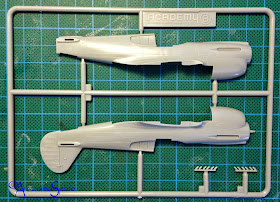Let's start a new project. This time will be the well known Curtiss fighter and backbone of the American Air Force in the beginning of World War Two, the P-40E.
There is an excellent article about those first P-40E's received by the Brazilian Air Force (FAB) in August 1942 written by Árpád Árbocz entitled: Cores e Camuflagens dos P-40E no Brasil (Colours and Camouflage for the P-40E in Brazil) here - (Sorry! Portuguese text only).
Basically, the first 6 aircraft to arrive in Brazil were part of Kittyhawk's MKIa lot originally destined to RAF. Therefore they had been delivered in the Temperate Land Scheme.
 |
| P-40E (US serial number: 41-36132) FAB 01 |
 |
| Profile representing the photo above |
Besides that above mentioned link, I will also relay on my most recently acquired book
According to Árpád Árbocz author of the above mentioned article, the most probable colour scheme translated to the Federal Standard representation would be:
That will be my guideline.
The Kit
I'll be using the Academy kit in 1/72 for this project.
 |
| The box art |
 |
| Sprue 1 |
 |
| Sprue 2 |
 |
| Sprue 3 |
 |
| Clear parts |
 |
| Instructions 1 |
 |
| Instructions 2 |
 |
| Instructions 3 |
 |
| Instructions 4 |
 |
| Instructions 5 |
 |
| Instructions 6 |
 |
| Instructions 7 |
 |
| Instructions 8 |
 |
| Instructions addendum with RAAF scheme |
 |
| Decal sheet |
 |
| The PE set |
 |
| PE instruction 1 |
 |
| PE instruction 2 |
 |
| Decal instructions |
 |
| FCM decal (unfortunately discontinued) |
Let's go!
I have started by adding the cockpit photoetcheds (PE). I was a little time consuming but I have managed to finish it without any incident. I used cianocrilate to glue it in place.
More progress.
I've painted the interior green and then painted some details in black and dry-brush lightly with aluminium.
Add the PE seat belts and painted it.
Finally glued the fuselage halves together.

Also added the PE for the landing gear bay and doors.
Closed the sides and ready to putty and sand paper.
The seams sanding was very short and it wasn't required to use putty at all. Just in case I did spray some interior green (that I was using to paint the head plate behind the seat) to check the seams. All looked good!
I also started to glue the wings by attaching the upper wing halves to the fuselage. I usually do that as a way to prevent gaps (and using putty+sanding) on the wings roots meeting the fuselage.
Continuing with this build I've glued the under side of the wings. All good and aligned properly. Little to sand on the edges but some putty/sanding required on the front wing roots and belly but nothing to be scared of.
I also installed the PE cooling slats. It really adds to the model.
A small but important step in my building process. I finally did mask the canopy. It is a tedious task and I was avoiding it, but it was also slowing me down since I could not progress with the building.
I started by giving the clear parts a bath into Future=Pledge and set aside to dry (usually overnight but it was more than one week before I begin to mask it). The Future helps to improve the clear parts.
Next step was to mask using small stripes of Tamiya masking tape. This canopy has very soft edges for the frames and required a lot of attention to finish.
Here are a couple of photos:
The fit was excellent and no extra filling or adjust was required.
After a break, I have returned to this building and completed the small parts construction and the bird was ready to receive it's feathers.
I did start the paint giving a wash with alcohol (methylated spirit here Down Under) on the entire model to clean all finger prints and mold release oils. Following I spray fine lines of Tamyia XF-1 Flat Black as an attempt of pre-shading.
For the underside I've used the Tamyia XF-21 SKY with one drop of XF-2 white to 5 drops of XF-21.
I also dis some small parts painting
More updates on the painting. I've painted the spinner using Tamiya XF02 Flat white and Tamiya Flat Red,
I have also started the upper surfaces camouflage. The first colour is RAF Dark Earth and I mixed Tamiya acrilics to achieve it using the following mix ratio: 3:XF02 Flat White + 2:XF64 Red brown + 1:XF10 Flat Brown.
I was pretty happy with the result. I did spray very light coats to slowly build up the paint without loosing the pre-shading.
In sequence I masked the model with Tamiya tape to prepare for the next camouflage colour.
For the RAF Dark Green I've used the Tamiya XF-81 straight from the bottle. The shade matches the reference accordingly.
In the photo above you can see some minor scratches in the Dark Earth camouflage, this will be re-touched later on and some paint scratches will be added with paintbrush.
I have finally finished this model. Unfortunately I haven't taken photos from the decal process.
I had a few issues with the decals, and I reckon was due being so old (believe me, they were more than 15 years old).
A list of the issues I had:
- some silvering that I could not fix;
- decal sheet didn't had the eyes for the shark, I had to brush paint them;
That's all folks, see you next time!
PHOTOS OF THE FINISHED MODEL































No comments:
Post a Comment